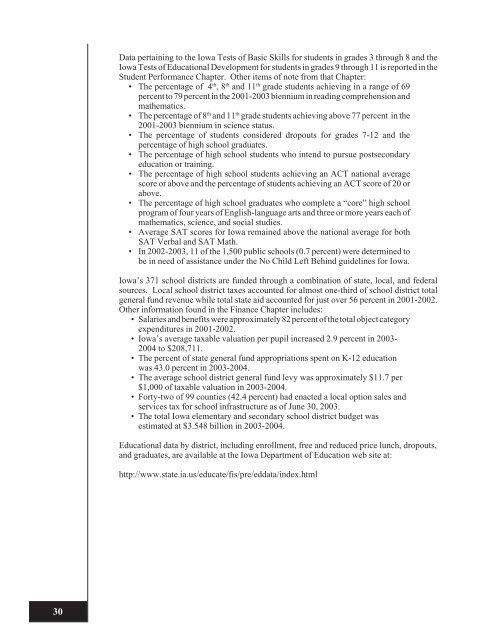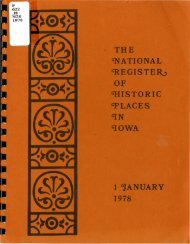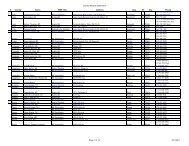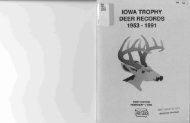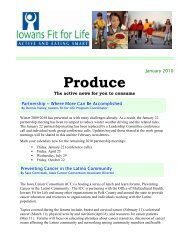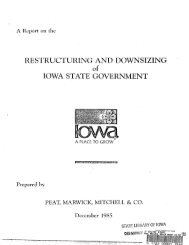Download (7Mb) - Iowa Publications Online - State of Iowa
Download (7Mb) - Iowa Publications Online - State of Iowa
Download (7Mb) - Iowa Publications Online - State of Iowa
Create successful ePaper yourself
Turn your PDF publications into a flip-book with our unique Google optimized e-Paper software.
Data pertaining to the <strong>Iowa</strong> Tests <strong>of</strong> Basic Skills for students in grades 3 through 8 and the<br />
<strong>Iowa</strong> Tests <strong>of</strong> Educational Development for students in grades 9 through 11 is reported in the<br />
Student Performance Chapter. Other items <strong>of</strong> note from that Chapter:<br />
• The percentage <strong>of</strong> 4 th , 8 th and 11 th grade students achieving in a range <strong>of</strong> 69<br />
percent to 79 percent in the 2001-2003 biennium in reading comprehension and<br />
mathematics.<br />
• The percentage <strong>of</strong> 8 th and 11 th grade students achieving above 77 percent in the<br />
2001-2003 biennium in science status.<br />
• The percentage <strong>of</strong> students considered dropouts for grades 7-12 and the<br />
percentage <strong>of</strong> high school graduates.<br />
• The percentage <strong>of</strong> high school students who intend to pursue postsecondary<br />
education or training.<br />
• The percentage <strong>of</strong> high school students achieving an ACT national average<br />
score or above and the percentage <strong>of</strong> students achieving an ACT score <strong>of</strong> 20 or<br />
above.<br />
• The percentage <strong>of</strong> high school graduates who complete a “core” high school<br />
program <strong>of</strong> four years <strong>of</strong> English-language arts and three or more years each <strong>of</strong><br />
mathematics, science, and social studies.<br />
• Average SAT scores for <strong>Iowa</strong> remained above the national average for both<br />
SAT Verbal and SAT Math.<br />
• In 2002-2003, 11 <strong>of</strong> the 1,500 public schools (0.7 percent) were determined to<br />
be in need <strong>of</strong> assistance under the No Child Left Behind guidelines for <strong>Iowa</strong>.<br />
<strong>Iowa</strong>’s 371 school districts are funded through a combination <strong>of</strong> state, local, and federal<br />
sources. Local school district taxes accounted for almost one-third <strong>of</strong> school district total<br />
general fund revenue while total state aid accounted for just over 56 percent in 2001-2002.<br />
Other information found in the Finance Chapter includes:<br />
• Salaries and benefits were approximately 82 percent <strong>of</strong> the total object category<br />
expenditures in 2001-2002.<br />
• <strong>Iowa</strong>’s average taxable valuation per pupil increased 2.9 percent in 2003-<br />
2004 to $208,711.<br />
• The percent <strong>of</strong> state general fund appropriations spent on K-12 education<br />
was 43.0 percent in 2003-2004.<br />
• The average school district general fund levy was approximately $11.7 per<br />
$1,000 <strong>of</strong> taxable valuation in 2003-2004.<br />
• Forty-two <strong>of</strong> 99 counties (42.4 percent) had enacted a local option sales and<br />
services tax for school infrastructure as <strong>of</strong> June 30, 2003.<br />
• The total <strong>Iowa</strong> elementary and secondary school district budget was<br />
estimated at $3.548 billion in 2003-2004.<br />
Educational data by district, including enrollment, free and reduced price lunch, dropouts,<br />
and graduates, are available at the <strong>Iowa</strong> Department <strong>of</strong> Education web site at:<br />
http://www.state.ia.us/educate/fis/pre/eddata/index.html<br />
30


